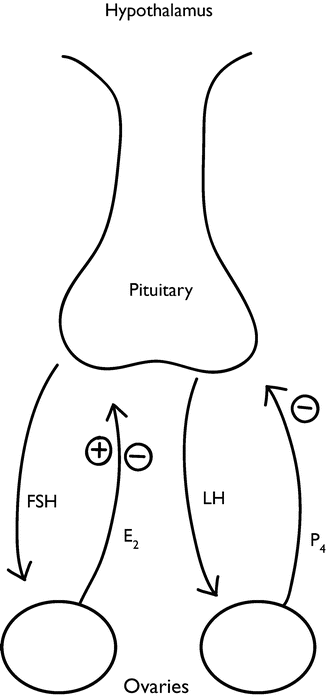and Paula Briggs2
(1)
Department of Obstetrics and Gynaecology, Monash University, Clayton, Victoria, Australia
(2)
Sexual and Reproductive Health, Southport and Ormskirk Hospital, Southport, UK
Understanding menstrual physiology is the basis for understanding the whole concept of fertility including the mechanism of action of contraception. It is also the basis for natural family planning.
Hormonal Control of Ovulation
The menstrual cycle is controlled by the hypothalamo- pituitary axis. The pituitary is a small gland the size of a cherry that sits at the base of the brain, behind the bridge of the nose. It is stimulated by Gonadotrophin Releasing Hormone (GNRH), a deca-peptide (a hormone made up of ten amino acids). GNRH is secreted from the hypothalamus via venous channels in a pulsatile manner (Fig. 1.1). It is the frequency and the amplitude of these pulses which determines the response from the pituitary gland. Follicle Stimulating Hormone (FSH), is secreted by the anterior pituitary gland and stimulates the Graafian follicles. FSH levels are higher in the early follicular phase of the menstrual cycle (initiating follicular development) than in the luteal phase. It has a small peak, which accompanies the very important Luteinising Hormone (LH) peak, just prior to ovulation. The anterior pituitary also secretes LH, which remains at basal levels throughout the cycle with the exception of the LH peak. The LH peak commences about 36 h prior to ovulation, and it last for 24 h, with the peak occurring 24 h prior to ovulation.


Fig. 1.1
The hypothalamo-pituitary-ovarian axis
Development of the Graafian Follicle
As the follicles start to develop from Day 1 of the cycle, the granulosa cells of the follicles start to secrete the hormone oestrogen. Oestrogen has an effect on many parts of the body and also has the effect of regulating the release of gonadotrophins. As the oestrogen level rises, the FSH secretion is reduced, so that usually only one follicle matures. This is a negative feedback. Various follicles have different sensitivity to FSH, and it is the most sensitive follicle, which becomes dominant, the one destined to ovulate. The other developing follicles undergo atresia. The hormone Inhibin (type A and B) is also secreted from the ovary and it too has an inhibitory effect on the pituitary with respect to FSH secretion.
The Effect of Oestrogen and Progesterone on the Endometrium
Circulating oestrogen causes both the glands and the stroma of the endometrium to proliferate. Following ovulation progesterone, is released resulting in secretory changes in the endometrium with tortuous glands containing lots of glycogen able to provide a welcoming nutritional environment should an embryo arrive.
Ovulation of the Follicle
When the follicle is ready to ovulate, oestrogen primes the pituitary gland to release LH. in a peak. This is responsible for the release of the ovum from the follicle about 36 h after the start of the rise, and 24 h after the LH peak. The hormone would more accurately be called “Ovulating Hormone” and that is what Luteinising Hormone means (as it induces the Corpus Luteum – yellow body- after ovulation).
Stay updated, free articles. Join our Telegram channel

Full access? Get Clinical Tree


